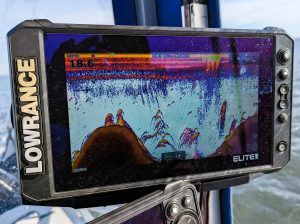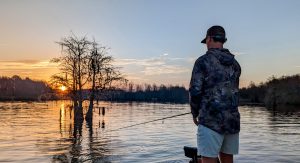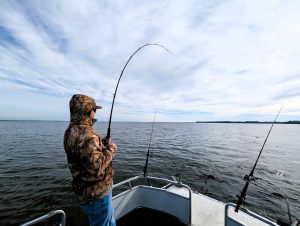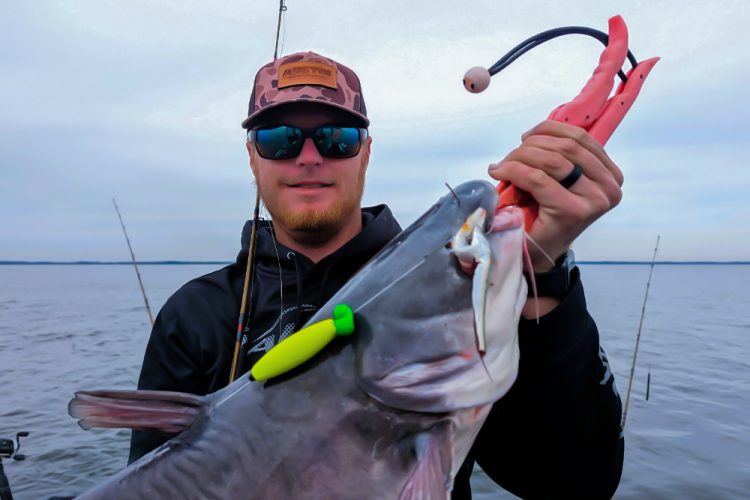Kyle Austin said catfish and bass share many qualities, and fishing
for both species makes him a better fisherman.
Use Bass Tactics to Catch More Catfish
Story and photos by Terry Madewell
Catfish and black bass share striking similarities in their behavior and habitat preferences. Understanding and respecting these common traits can significantly enhance your catfishing success.
Good catfishing advice often comes from unexpected sources. I remember a chance encounter with a seasoned river rat at a local boat landing. Little did I know that this meeting would forever change my perspective on catfishing.
I was launching, and he was loading up, and we struck up a conversation.
Based on his boat, gear and set-up, I correctly identified him as a catfish angler, but I didn’t anticipate our conversation would change my perspective on catfishing.
I told him I was likely in for a tough day of catfishing. I hadn’t been recently because I’d been focused on catching largemouth bass.
He cut a wry smile and shook his head.
“It’s your own dang fault if you don’t catch a mess,” he said.
He opened his cooler, and it was loaded with catfish, primarily blue catfish, with a few channel and flathead catfish mixed in.

“If the catfish aren’t in the shallows, or in some of the deep holes, most folks think the fish aren’t biting,” he said. “What that tells me is the fish are on different underwater features. It’s on me to find them.
“Bass fishermen spend hours searching for patterns, knowing they can catch a limit once they figure it out,” he continued. “But catfishermen seem to expect the catfish to come to them. No, sir, you’ve got to treat catfish with the same respect you do largemouth bass; you’ve got to hunt them down.”
He nailed it. It’s not about waiting for the fish to bite, but about actively seeking them.
Catfish and black bass share striking similarities in their behavior and habitat preferences. Understanding and respecting these common traits can significantly enhance your catfishing success.
Some of the best bass fishermen make the best catfishermen. A perfect example is professional bass fisherman Kyle Austin of Ridgeville, South Carolina, winner of the 2024 St. Croix Bassmaster Open at South Carolina’s Santee Cooper lakes. At the age of 26, he’s also fished the Bassmaster Classic.
But when Austin isn’t touring the pro bass fishing circuit, he’s on his home waters—the Santee Cooper lakes, Marion and Moultrie—working as a professional guide for catfish and bass. Of the 150 days a year he guides, nearly 70 percent of trips are for catfish. Immediately after his first big BASS win, he switched boats and started guiding for catfish.
“For me, fishing for bass and catfish shares common, identifiable similarities,” he said. “I believe that when fishing for either one, it helps me become a better angler for both.
“I love fishing for catfish, especially guiding and taking people fishing who often catch the biggest fish of their lives. For me, catfishing and bass fishing strategies mesh perfectly. I think each has attributes that help me become a better overall fisherman.”

It’s not that Austin is a bass fisherman who fishes for catfish; he’s a fisherman who relies on proven tactics and strategies to fish for either species. By being a professional fishing guide for two species that many consider opposites, he’s learned that both species teach him about fish behavior, including seasonal patterns, locations and forage preferences.
“Bass fishing has helped me define the seasonal movements of catfish because I learned early that bass are seasonal in where they’re found and which tactics work best,” he said.
Austin (843-209-3726; Kyle Austin Fishing on Facebook) said the specific locations are not the same for bass and catfish, but the thought process for defining them is remarkably similar.
“Catfish are generally not in the same places I’ll find bass, but many fish-finding concepts are the same,” he said. “Both species routinely orient to depth changes, with creek ledges, river channels, deep holes, points and humps all productive for either species at specific times of the year.”
But the specific requirements of a hump to hold bass are usually different than the preferences of catfish. The makeup of the hump may be different, but the concept of orienting to that type of underwater feature is attractive for both species.
For catfish, a hump with a mussel bed located in the substrate is a prime target, Austin said. But a hump that has stumpy or woody cover as ambush points can be perfect for bass to ambush schools of shad. Perhaps not the same hump for both, although that’s possible, but it illustrates the similarity of habitat choices.
Forage is another linked similarity.

“Both species are directly linked to forage movement in terms of where I find them,” he said. “Some forage species such as threadfin and gizzard shad overlap in the Santee Cooper lakes. But catfish also have seasonal preferences, including saltwater herring that migrate through the lakes in the spring on a spawning run. During the winter, menhaden get into Lake Moultrie in big numbers and are a reliable catfish forage pattern.”
For bass, the shad connection is often a direct link, but they also feast on abundant sunfish species, as well as crawfish, a prized bass treat. Fishing patterns develop around those forage opportunities.
“When I’m catfishing between tournaments, the actual fishing, and having to work out patterns on the spot to keep clients on fish, makes me a better bass fisherman, because it keeps me mentally sharp,” he said. “Success in bass fishing is the ability to adapt to ever-changing forage and water situations, just as it is with catfish.
“I believe guiding for catfish, when I’m not fishing in bass tournaments, is the ideal preparation for the next bass tournament,” he said.
Catfishing is as simple or complex as you want to make it, but success is linked to what the “River Rat” said, and what Austin does—he respects both species. Anglers willing to expend the effort to treat catfish with the same respect level afforded to bass may be rewarded with catfishing action they only dreamed possible.
Release your inner bass fishing mindset to catch more catfish. And, if you ever tire of catching catfish, you may find some new bass-fishing spots along the way!
(Terry Madewell of Ridgeway, S.C., has been an outdoor communicator for nearly 50 years. He holds a degree in Wildlife and Fisheries Management and has a long career as a professional wildlife biologist/natural resources manager. He’s passionate about sharing outdoor adventures with others.)



